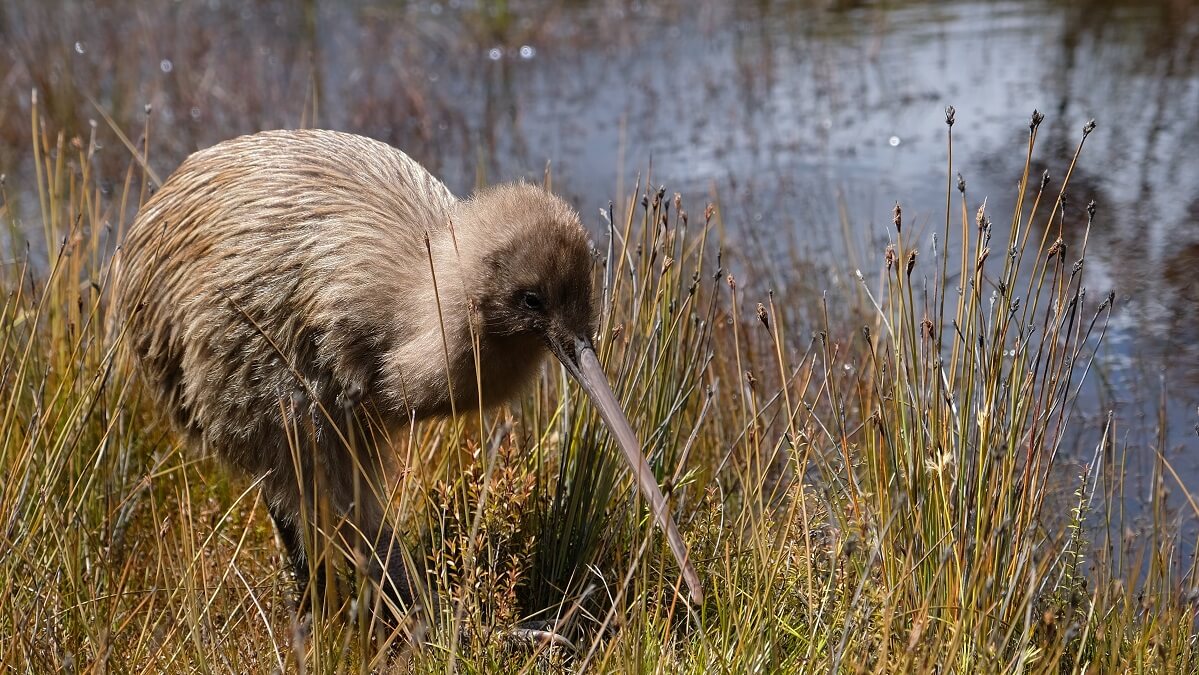New Zealand’s national symbol is a shy little character that usually only makes an appearance after dark.
Unsurprisingly perhaps, given the threat these flightless birds face from introduced predators such as stoats and ferrets.
Despite hatching from the egg fully feathered and able to feed themselves, they often require a little help from their human friends to make it to adulthood. Programs such as the National Kiwi Hatchery play an important role in kiwi conservation by incubating eggs and hatching chicks at centres around New Zealand.
Despite their relatively small numbers, you can see this bird in real life at numerous kiwi houses and sanctuaries around New Zealand. If you are really lucky, you might even catch a glimpse of one in the wild.
Read: Where to travel in New Zealand
Kāpiti Island, Wellington
The Kāpiti Island Nature Reserve, 5km off the west coast at the southern end of the North Island, is one New Zealand’s most important sites for bird recovery. The little spotted kiwi, now extinct from the mainland forests, also thrives on Kāpiti Island. Kāpiti Island Nature Tours offer return ferry transfers, day trips and overnight kiwi spotting tours.
National Kiwi Hatchery, Rotorua
The hard work of kiwi experts at the National Kiwi Hatchery in Rotorua has led to more than 2000 successful hatchings and they play a hugely important role in kiwi conservation. Visitors can view the incubation and hatching work by purchasing a National Kiwi Hatchery tour.
Orokonui Sanctuary, Dunedin
The 307ha Orokonui Eco-Sanctuary – 20km north of Dunedin – is restoring an entire forest ecosystem to its pre-human state. Visit the kiwi creche where the team raises the rarest of all kiwis, the Haast tokoeka.
Otorohanga Kiwi House
Otorohanga Kiwi House has been conserving kiwi and other New Zealand natives since 1971. Visitors can learn about their active brown kiwi breeding program from the friendly and knowledgeable guides in the heart of the North Island.
Pukaha National Wildlife Centre. Wairarapa
Pukaha Mount Bruce National Wildlife Centre, in the Wairarapa, pioneered captive breeding techniques for some of the New Zealand’s most threatened birds.
Read: New Zealand’s secret wine region
Rakiura/Stewart Island
Stewart Island Wild Kiwi Encounter is one of the ultimate kiwi experiences. Join an expert guide as you enjoy a short boat ride, followed by a walk through coastal forest, before reaching Ocean Beach. Here in the darkness, you will get to see the southern brown kiwi (Rakiura tokoeka) in the wild as it searches for its dinner.
Rotoroa Island, Auckland
Auckland’s Rotoroa Island lies in the Hauraki Gulf and is home to more than 25 North Island brown kiwi. There is accommodation on the island, so stay the night for your best chance of seeing or hearing a kiwi.
Sanctuary Mountain Maungatautari, Cambridge
Rare and endangered New Zealand wildlife – including takahe, kiwi and tuatara – are thriving on Sanctuary Mountain at Maungatautari, a unique eco sanctuary near Cambridge. The sanctuary offers private night-time tours and the opportunity to be a part of a kiwi release.
Read: The sounds of New Zealand
Willowbank Wildlife Reserve
Willowbank Wildlife Reserve in Christchurch incubates eggs for up to four species of kiwi – Ōkarito rowi, Haast tokoeka, great spotted and North Island brown. Visit the reserve to see the dedicated team in action as they continue to hatch and re-release kiwi back into the wild.
Zealandia, Wellington
Just a few minutes by car from downtown Wellington and nestled in a forested valley, Zealandia is an outdoor haven for some of New Zealand’s rarest native birds and animals and a living monument to world-leading conservation efforts. On a night-time tour, you may just spot one of the 150 little spotted kiwis that call Zealandia home.
Have you ever spotted a kiwi in the wild? Why not share your experience in the comments section below?

